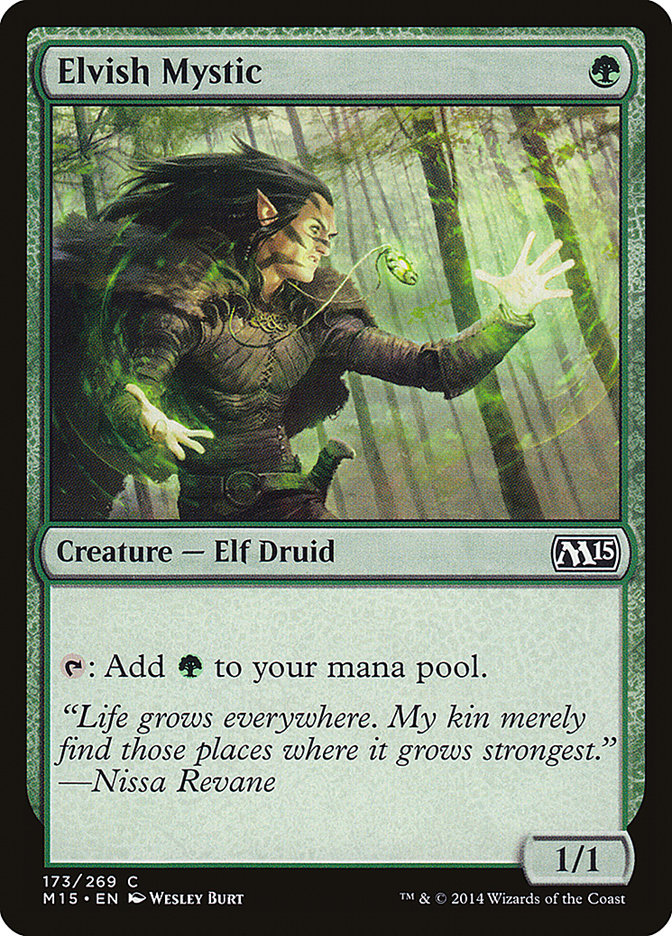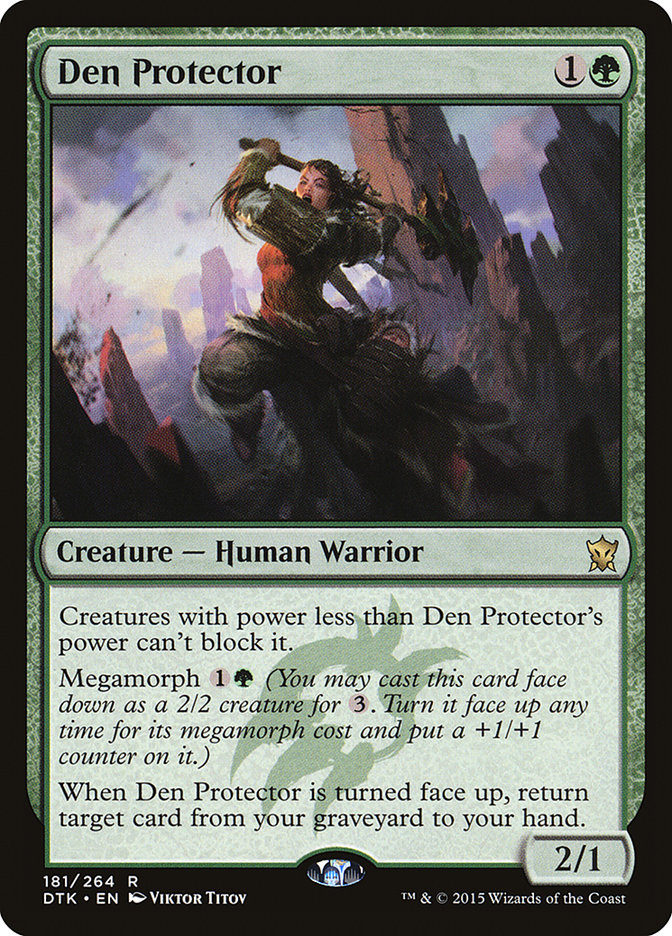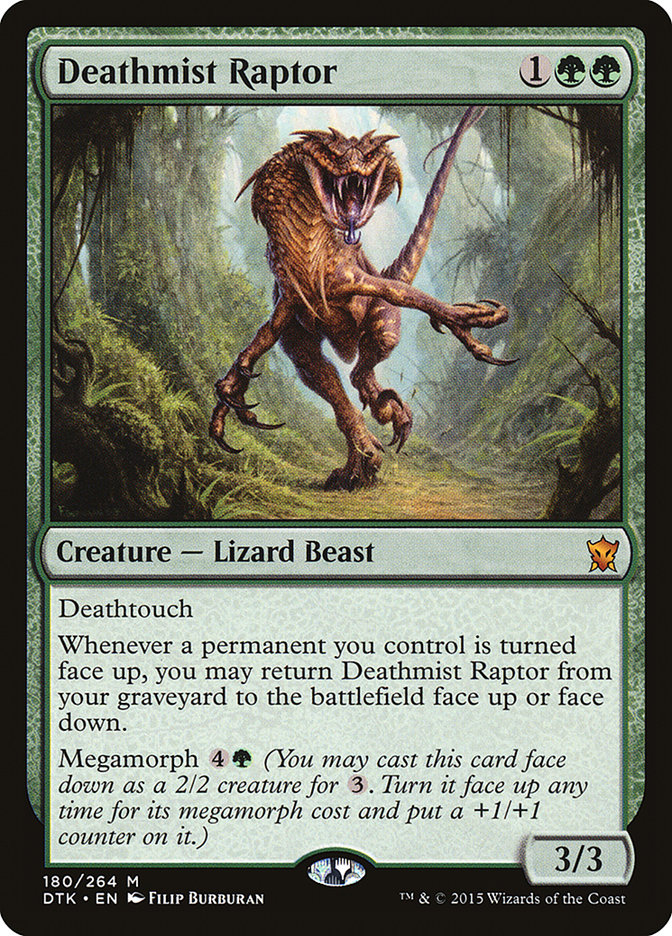The week leading up to an Invitational is generally always filled with millions of hours of grinding, figuring out what the best deck for the tournament is, and keeping sharp for that tournament.
I didn’t do any of this, and for good reason.
Most of my tournament deck choices are based off of feel, and in a big tournament like this one, where no one really knows what’s going to happen, I knew I just wanted to have a plan and execute that plan as best as possible.
That meant starting with this card:

I knew that many of my decks were going to start with this card because of how much of an immediate impact it has on the game. I’m all about coming into the fray guns ablazing, and what better way to do that than to threaten to jump the curve at every opportunity? One of the bigger questions was how I wanted to use Elvish Mystic. I dismissed G/W fairly quickly – not because it wasn’t good but because it wasn’t really my speed. I also knew that whatever I came up with would just be a weaker version of whatever Andy Boswell would have. This left me with G/R-based decks.
One of my early builds involved being as explosive as possible with Atarka’s Command and four-drops:
Creatures (28)
- 4 Elvish Mystic
- 4 Stormbreath Dragon
- 4 Boon Satyr
- 4 Goblin Rabblemaster
- 1 Rattleclaw Mystic
- 4 Heir of the Wilds
- 4 Thunderbreak Regent
- 3 Surrak, the Hunt Caller
Lands (23)
Spells (9)

I went into the lab with a couple of friends of mine, Robert Pompa and Luis Alfonso, and I got to work. The goal wasn’t to figure out what’s well-positioned, what the best deck was, or anything like that. I wanted to figure what the best version of my game-plan would look like, and we spent most of the day doing just that.
We collectively concluded that Atarka’s Command was pretty damn powerful, but it wasn’t quite the card I wanted when it came to how I envision games playing out. I wanted to press an advantage I already had on board, and the Command was only really good once you got there – it wasn’t really helpful at putting you in that position in the first place, which made it an excellent card I didn’t really need any more of. One of the many good things about working with Robert in general is that he’s one of the only players in Magic that knows how I see the game and doesn’t try to push me into an absolutist viewpoint. He understands that I’m pretty certain of what I want to do, but I have a hard time actually getting there. Maybe it’s the years of Birthing Pod activations that made that happen…
So, where did I want to be? I had a few ideas:
First, I wanted a reasonable density of two-drops to cover me when I’m not on an Elvish Mystic draw… or in the event that Wild Slash is very popular. Taking the initiative is extremely powerful, but it’s really easy to take it back. We had to do something about that.
Second, I wanted something lean and cohesive. I didn’t want a bunch of big dummies that were oversized, undercosted, and didn’t really do much outside of that. That wasn’t working before. All of the big dummies in Standard did something now, and it just wasn’t cutting it.
Lastly, I wanted to make sure I wasn’t missing anything. The obvious cards were there, but I wanted to be as open to anything as possible. I talked to a lot of people I trust, and I was pretty sure I had things where I wanted.
Then I got a Facebook message:
Creatures (27)
- 4 Elvish Mystic
- 4 Stormbreath Dragon
- 4 Rattleclaw Mystic
- 4 Heir of the Wilds
- 4 Thunderbreak Regent
- 3 Den Protector
- 4 Deathmist Raptor
Lands (23)
Spells (10)

The last time AJ sent me a G/R/x deck, we created one of the best decks I’ve ever played in Jund Aggro a few years back, and I had a really strong hunch about this one too. I did, in fact, miss two cards… and they’re really powerful ones:


Den Protector is one of those cards that doesn’t feel very powerful at first glance but it fills very specific roles at all points in the game. You have a serviceable two-drop that is pretty solid when you cast it face-down on turn two (with help from Elvish Mystic), assists Deathmist Raptor, rebuys Crater’s Claws and threats, and doesn’t get blocked by tokens. A fine inclusion in a deck that wanted solid two-drops.
Deathmist Raptor, however, is an entirely different animal. It’s just so incredibly powerful at almost everything we’ve been looking for in G/R decks. It isn’t flashy like Boon Satyr, nor does it have as much offensive power as Goblin Rabblemaster, but the amount of resistance it provides against traditional removal is super high while always trading up on both offense and defense. I actually missed this card when building decks before, and I’m glad it was presented this way. This garnered some radical changes to how I viewed the format, and I spent the entire trip working on it.
We concluded that we had two builds to choose from. The first build had a plan of being as aggressive as possible and just jamming unreasonably large creatures, plus Surrak, the Hunt Caller to keep the momentum going. The second had more cohesion, was more streamlined, and had more play in spots where the more-aggressive version didn’t. We opted for the latter, with a little bit of divergence between us.
I wound up registering this:
Creatures (27)
- 4 Elvish Mystic
- 4 Stormbreath Dragon
- 3 Goblin Rabblemaster
- 3 Rattleclaw Mystic
- 4 Heir of the Wilds
- 4 Thunderbreak Regent
- 1 Den Protector
- 4 Deathmist Raptor
Lands (23)
Spells (10)

This was basically how I envisioned the deck, and I was pretty excited to jump into the fray. I quickly learned that many of the usual group of players that I hang with were on the deck as well, which was cool.
I played some incredibly close matches during the Standard portion, but I realized almost immediately that I was missing a few pieces to push the deck even further. Roast, while powerful, would clog up the flow of the game at times, which is weird because you’d expect to have such a great removal spell add to the fluidity. Goblin Rabblemaster is a great free-win card, but the opportunities for those free wins are becoming much smaller lately and you just might be better off opting for more synergy and cohesion than raw power. You already have plenty of power on the top end of the curve anyways.
While I missed Day Two in my last round, I was ready to continue battling in the Open. When the day was over, I was becoming more interested in how to make the deck better and the idea of playing white instead of red was brought up. You wind up with Dromoka’s Command, which is ludicrously powerful, plus you get another actual two-drop in Fleecemane Lion and some pretty solid sideboard cards. You lack a four-drop that’s as solid as Thunderbreak Regent, but you’re much better equipped for the longer game and can play defense really well too.
I decided to sleep on it and think about…
“What if we splash for Siege Rhino?”
What if we what!?!
Creatures (28)
- 4 Fleecemane Lion
- 3 Boon Satyr
- 4 Heir of the Wilds
- 4 Siege Rhino
- 4 Whisperwood Elemental
- 4 Warden of the First Tree
- 1 Den Protector
- 4 Deathmist Raptor
Planeswalkers (1)
Lands (25)
Spells (6)

It may not be the cleanest build, but the idea was there and I was going to give it a go. Similar to the R/G Aggro deck, there were just a few pieces missing to really push this over the top, and a lot of those pieces were in the sideboard. We couldn’t do much about decks that tried to attack us wide, and we could have a hard time actually keeping creatures on the board, which would leave us stranded with Dromoka’s Comands that we couldn’t do anything with. Drown in Sorrow is rough because our manabase is built with the bare minimum for a splash, and End Hostilities is counterintuitive at best, though it may just be the card available for that job.
The deck performed very well, but unfortunately I didn’t. I was once again in it up until the last round of the first day, needing a win to continue on, and that didn’t happen. This one kind of got to me, mostly because of how important Season Two is for me in my quest to make the Players’ Championship. I knew better than that. The real goal is to just get better, every single day, no questions asked, and I can’t keep losing sight of that. Yes, I know it sounds like a broken record every other week, but I cannot stress enough how important and true that is.
Looking back to the decks I chose to play, here’s how I would improve them:
For the R/G deck, I think that Haven of the Spirit Dragon is secretly one of the best cards in the deck, and it should certainly be in the main. I also think that Sarkhan Unbroken would help push the deck over the top, but that feels like it works more in my head than it might in actual reality, and we’d have to figure out the manabase. Here’s what I’d do if going that route isn’t feasible:
Creatures (30)
- 4 Elvish Mystic
- 4 Stormbreath Dragon
- 4 Goblin Rabblemaster
- 4 Rattleclaw Mystic
- 3 Heir of the Wilds
- 4 Thunderbreak Regent
- 4 Deathmist Raptor
- 3 Surrak, the Hunt Caller
Lands (23)
Spells (7)

There are a whole ton of other options we could go with as well. Fanatic of Xenagos is still a really strong card, especially if Ultimate Price is making as strong a presence as it seemed to be for week one. Maindecking Chandra, Pyromaster is also a good option if you’re trying to beat all the other non-Thunderbreak Regent midrange decks. Xenagos, the Reveler and Xenagos, God of Revels are both fine ways to dictate the pace of the game, as they excel at leveraging every offensive resource you have.
The crazy part about all of this is that we’re just scratching the surface on how big of an impact Dragons of Tarkir has had on the format. I’m of course rooting for Ross Merriam to win the whole thing (and that’s completely and utterly unbiased) but as of the time I’m writing this it’s still really up in the air who will take it down. Every deck is good. Almost every card is powerful, and the balance is just right, all at the same time.
